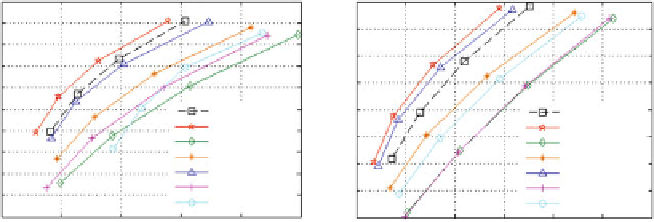Image Processing Reference
In-Depth Information
a
b
44
42
40
38
36
42
40
38
36
34
34
HEVC
HEVC
3DHolo
3DHolo
32
30
28
26
24
32
30
VI-based 3DHolo
VI-based 3DHolo
RI-based 3DHolo
RI-based 3DHolo
MI-based PVS
MI-based PVS
VI-based PVS
28
VI-based PVS
RI-based PVS
RI-based PVS
26
0
0.5
1
1.5
2
2.5
0
0.5
1
1.5
2
2.5
3
[bpp]
[bpp]
Fig. 5.15 RD performance of Simulcast Coding for: (a) Plane and Toy; and (b) Laura
6.
VI-based PVS
: This solution corresponds to the solution proposed in [
10
] and
referred to as VI-based PVS. In this case, a PVS formed from all viewpoint
images is encoded with HEVC “Low Delay, main, P slices only” configuration
[
29
]. In this case, the largest coding block is also 16
16.
7.
RI-based PVS
: This solution corresponds to the solution proposed in [
10
] and
referred to as RI-based PVS. In this case, a PVS formed from all ray-space
images is encoded with HEVC “Low Delay, main, P slices only” configuration
[
29
]. In this case, the largest coding block is also 16
16.
The RD performance is presented in Fig.
5.15
for each tested image in terms of
luma Peak Signal to Noise Ratio (PSNR) versus average bits per pixel (bpp).
From the presented results, it is possible to conclude that solutions based on
micro-image representations (i.e.,
3DHolo
and
MI-based PVS
solutions) are con-
siderably more efficient compared to the corresponding viewpoint images and
ray-space images representations using the same coding scheme.
In addition, by comparing now the performance of solutions based on the MI
representation, it is possible to see that
3DHolo
solution always outperforms all the
other solutions, with gains that go up to 2.2 dB when compared to HEVC and 0.7 dB
when compared to the MI-based PVS (for
Laura
, in Fig.
5.15b
).
5.5.2 Experimental Results for Scalable 3D Holoscopic
Coding
The RD performance of the described scalable coding solution for 3D holoscopic
content is evaluated in this section.
To generate the content for the first two scalability layers, the two test images
were processed with both algorithms presented in Sect.
5.3.4
(Basic Rendering and
Weighted Blending). In this process, nine 2D views were generated—one for the
Base Layer
and eight for the
First Enhancement Layer
. Two sets of patch sizes were

